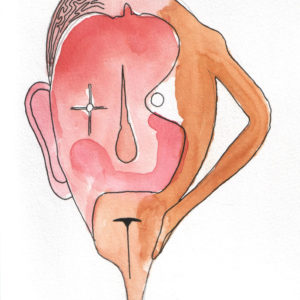Commission paintings via mat.jupe@hotmail.co.uk
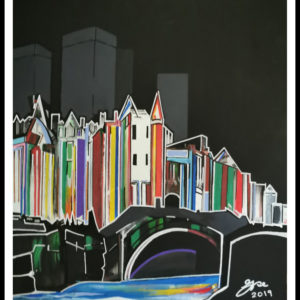
City Scape
City Scape is a 50 x 60cm acrylic painting on hard board. It is a fantasy representing the sights you find in European cities. In the foreground, an elaborate canal system and narrow houses with gabled facades, legacies of Amsterdam’s 17th-century Golden Age and the skyscrapers of Paris and London in the back ground.
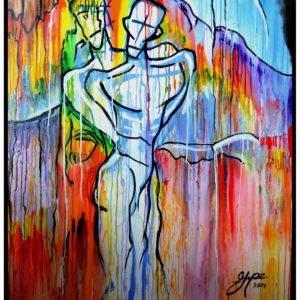
Couple Shower, Dressed in Light – Original (120cm x 100cm)
Couple Shower, Dressed in Light
Couple Shower, Dressed in Light is a large acrylic, painted on a 120cm by 100cm box canvas during 2014. At first I thought the figures where androgynous but it soon became apparent that they were male. The scythe in the sky? Well I wanted it set during a full moon, but as soon as I started to paint it in; there looking back at me was a scythe!
I don’t see it as foreboding. If anything I see as saying, ‘look I am here in the background, so make every moment count.’
A cavalcade of colour. This shower scene, cave painting, colorizes the grotto of rocks and water surrounding our two bathers. This shower scene, cave painting, colorizes the grotto of rocks and water surrounding our two bathers.
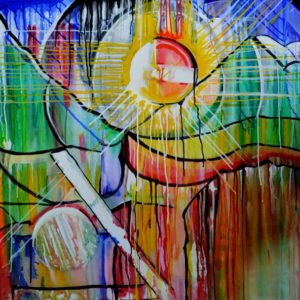
Summer in Scotland – Sunshine Pouring onto the Mountains
Summer in Scotland is a depiction of Scotland through rain and shine. Even the sun is raining onto the ‘divine’ mountains and pours onto the arable pasture.

Je Suis Parasaurolophus
Je Suis Parasaurolophus (1m x 1m)
Dinosaurs are available at all scales, bespoke to your room.
Parasaurolophus meaning “near crested lizard” in reference to Saurolophus, is a genus of ornithopod dinosaur that lived in what is now North America during the Late Cretaceous Period, about 76.5–73 million years ago. It was a herbivore that walked both as a biped and a quadruped. Three species are recognized: P. walkeri (the type species), P. tubicen, and the short-crested P. cyrtocristatus. Remains are known from Alberta (Canada), and New Mexico and Utah (USA). The genus was first described in 1922 by William Parks from a skull and partial skeleton found in Alberta.
Parasaurolophus was a hadrosaurid, part of a diverse family of Cretaceous dinosaurs known for their range of bizarre head adornments. This genus is known for its large, elaborate cranial crest, which at its largest forms a long curved tube projecting upwards and back from the skull. Charonosaurus from China, which may have been its closest relative, had a similar skull and potentially a similar crest. Visual recognition of both species and sex, acoustic resonance, and thermoregulation have been proposed as functional explanations for the crest. It is one of the rarer hadrosaurids, known from only a handful of good specimens.
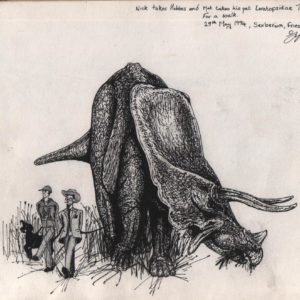
Walking With Triceratops
Walking With Triceratops
A favourite pencil, pen and ink drawing of Nick, walking his dog and Matthew, walking his Triceratops. 19cm x 14cm (image size). 31cm x 26cm (framed size).
The dinosaur belongs to a genus of herbivorous ceratopsid dinosaur that first appeared during the late Maastrichtian stage of the late Cretaceous period, about 68 million years ago (mya) in what is now North America. It is one of the last known non- avian dinosaur genera, and became extinct in the Cretaceous–Paleogene extinction.
The dinosaur’s name, which literally means “three-horned face”, is derived from the Greek τρί- (tri-) meaning “three”, κέρας (kéras) meaning “horn”, and ὤψ (ops) meaning “face”. It has been documented by numerous remains collected since the genus was first described in 1889, including at least one complete individual skeleton. Paleontologist John Scannella observed: “It is hard to walk out into the Hell Creek Formation and not stumble upon a Triceratops weathering out of a hillside.” Forty-seven complete or partial skulls were discovered in just that area from 2000 to 2010. Specimens representing life stages from hatchling to adult have been found. As the archetypal ceratopsid, Triceratops is one of the most popular dinosaurs, and has been featured in film, postal stamps, and many other types of media.
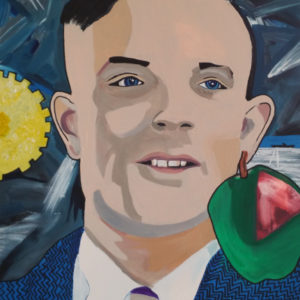
The Alan Mathison Turing Test -11101111000 or 1912
Alan Mathison Turing
The portrait of Alan Turing is not for sale for anything less than the asking price. The proceeds of the sale of this piece will go towards mental health, student and gay support charities.
Alan Mathison Turing, OBE, FRS (23 June 1912 – 7 June 1954) was a British pioneering computer scientist, mathematician, logician, cryptanalyst, philosopher, mathematical biologist, and marathon and ultra distance runner. He was highly influential in the development of computer science, providing a formalisation of the concepts of algorithm and computation with the Turing machine, which can be considered a model of a general purpose computer. Turing is widely considered to be the father of theoretical computer science and artificial intelligence.
My title for the portrait is ‘The Alan Mathison Turing Test -11101111000. The number is his birthday in binary code and I asked for that to be used as the asking price for the portrait. The proceeds of the sale of this piece will go towards mental health, student and gay support charities. Now there are two ways to calculate this number…either take it at face value and pay £11101111000 or change the number from binary base 2 to decimal base 10 and end up with Alan Turing’s birth date of 1912. In my opinion the binary base 2 is the correct evaluation of this piece and the money would go towards charities and benefit individuals who work in difficult if not impossible conditions.
During the Second World War, Turing worked for the Government Code and Cypher School (GC&CS) at Bletchley Park, Britain’s codebreaking centre. For a time he led Hut 8, the section responsible for German naval cryptanalysis. He devised a number of techniques for breaking German ciphers, including improvements to the pre-war Polish bombe method, an electromechanical machine that could find settings for the Enigma machine. Turing played a pivotal role in cracking intercepted coded messages that enabled the Allies to defeat the Nazis in many crucial engagements, including the Battle of the Atlantic; it has been estimated that this work shortened the war in Europe by as many as two to four years.
After the war, he worked at the National Physical Laboratory, where he designed the ACE, among the first designs for a stored-program computer. In 1948 Turing joined Max Newman’s Computing Laboratory at the University of Manchester, where he helped develop the Manchester computers and became interested in mathematical biology. He wrote a paper on the chemical basis of morphogenesis, and predicted oscillating chemical reactions such as the Belousov–Zhabotinsky reaction, first observed in the 1960s.
Turing was prosecuted in 1952 for homosexual acts, when such behaviour was still a criminal act in the UK. He accepted treatment with oestrogen injections (chemical castration) as an alternative to prison. Turing died in 1954, 16 days before his 42nd birthday, from cyanide poisoning. An inquest determined his death a suicide, but it has been noted that the known evidence is equally consistent with accidental poisoning.[8] In 2009, following an Internet campaign, British Prime Minister Gordon Brown made an official public apology on behalf of the British government for “the appalling way he was treated”. Queen Elizabeth II granted him a posthumous pardon in 2013.
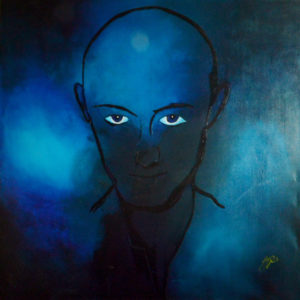
Moody Marty – Sure Does Have The Blues
‘Moody Marty – Sure Does Have The Blues’ is a 1m x 1m canvas of my dear friend Marty. It is painted in Windsor Blue, Titanium White and Mars Black acrylics. At present it is unframed although this can be accomplished here or at the purchasers prefered framers.
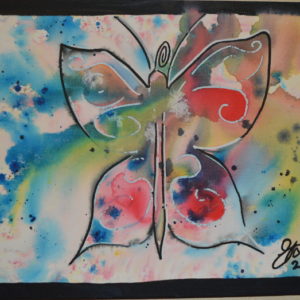
Lepidoptera No.1 – Splendens
Lepidoptera No.1 – Splendens
This is a 45cm x 35cm acrylic on canvas. I painted it in celebration of a work colleague’s birthday.
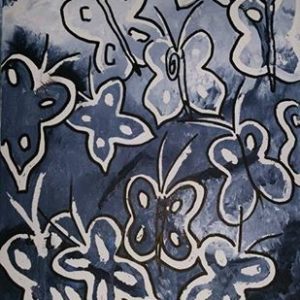
Lepidoptera No.2 – The Grey Gathering
Lepidoptera No.2 – The Grey Gathering
This is a 35cm (H) x 28cm (W) acrylic painting. I have used a masking fluid to reveal lots of butterflies underneath the field of Paynes grey and titanium white.
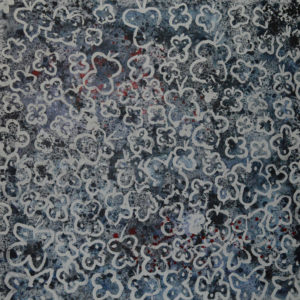
Lepidoptera No.5 – The Great Grey Fluttering
Lepidoptera No.5 – The Great Grey Fluttering is a 100cm (H) x 100cm (W) x 3.5cm (D) acrylic painting. I have used patches of crimson, Paynes grey and titanium white and masking fluid to reveal one hundred, fluttering butterflies. This is the largest of the Lepidoptera series… so far! This painting was painted in the Spring of 2018 and joins the four other butterfly paintings in this series. I enjoy this form of expression so I will add to this collection in the future.
Butterflies are insects in the Order Lepidoptera, which also includes moths. Adult butterflies have large, often brightly coloured wings, and conspicuous, fluttering flight. Butterfly fossils date to the Paleocene, which was about 56 million years ago.
Butterflies have the typical four-stage insect life cycle. Winged adults lay eggs on the food plant on which their larvae, known as caterpillars, will feed. The caterpillars grow, sometimes very rapidly, and when fully developed, pupate in a chrysalis. When metamorphosis is complete, the pupal skin splits, the adult insect climbs out, and after its wings have expanded and dried, it flies off. Some butterflies, especially in the tropics, have several generations in a year, while others have a single generation, and a few in cold locations may take several years to pass through their entire life cycle.
Butterflies are often polymorphic, and many species make use of camouflage, mimicry and aposematism to evade their predators. Some, like the monarch and the painted lady, migrate over long distances. Many butterflies are attacked by parasites or parasitoids, including wasps, protozoans, flies, and other invertebrates, or are preyed upon by other organisms. Some species are pests because in their larval stages they can damage domestic crops or trees; other species are agents of pollination of some plants. Larvae of a few butterflies (e.g., harvesters) eat harmful insects, and a few are predators of ants, while others live as mutualists in association with ants. Culturally, butterflies are a popular motif in the visual and literary arts.
(most text abridged from the wikipedia page on Butterflies)
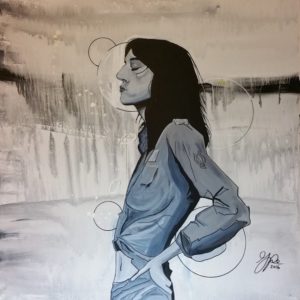
Patti Smith
Patti Smith
Patti Smith striking one of her iconic poses. This painting was created after visiting an old friend a Patti Smith die hard, Debbi Marshal. The 1m x 1m acrylic uses Signal Black and white for the background and Paynes Grey and white for the subject.
Patricia Lee “Patti” Smith (born December 30, 1946) is an American singer-songwriter, poet and visual artist who became a highly influential component of the New York City punk rock movement with her 1975 debut album Horses.
Called the “punk poet laureate”, Smith fused rock and poetry in her work. Smith’s most widely known song is “Because the Night”, which was co-written with Bruce Springsteen. The song reached number 13 on the Billboard Hot 100 chart in 1978. In 2005, Patti Smith was named a Commander of the Ordre des Arts et des Lettres by the French Ministry of Culture, and in 2007, she was inducted into the Rock and Roll Hall of Fame. On November 17, 2010, she won the National Book Award for her memoir Just Kids. The book fulfilled a promise she had made to her former long-time roommate and partner, Robert Mapplethorpe. In Rolling Stone magazine’s list of 100 Greatest Artists published in December 2010, she was in 47th place. She is also a recipient of the 2011 Polar Music Prize.
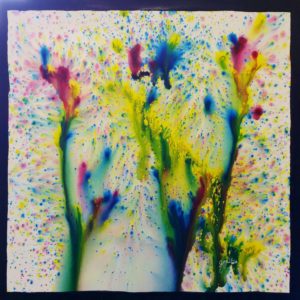
Flowers of Ascension No.1 – Pollination
Flowers of Ascension No.1
Flowers of Ascension No.1 , is a 24″ x 24″ acrylic on canvas painting which magnifies the abundance of pollen in the air that affects so many people in high summer. The black board keeps our attention focused on the myriad of particles trapped in the painting.
The Flowers of Ascension represent flower like energies rising to Paradise after death.

Flowers of Ascension No.2
Flowers of Ascension No.2
Flowers of Ascension No.2 is 50cm x 50cm, box framed acrylic painting of a fantasy of flowers and forms a pair along side Flowers of Ascension No.3 also 50cm x 50cm.
The Flowers of Ascension represent flower like energies rising to Paradise after death..
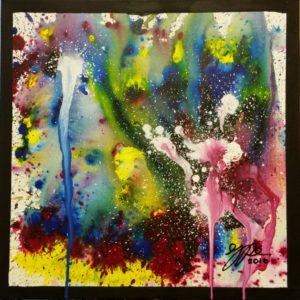
Flowers of Ascension No.3
Flowers of Ascension No.3
Flowers of Ascension No.3 is a 50cm x 50cm box framed acrylic painting of a fantasy of flowers and forms a pair along side Flowers of Ascension No.2 (also the same dimensions)
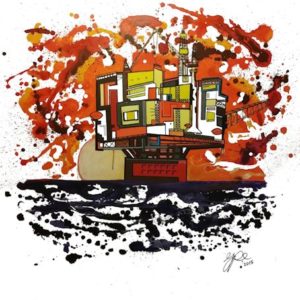
Ninian Central – Glowing at Twilight
The Ninian Central Platform is located in the North Sea. It was built in Loch Kishorn, Scotland in 1978. At a colossal 600,000 tonnes the platform was the world’s largest man-made movable object before being towed to its current position and fixed to the sea floor.
It is a circular concrete gravity structure, 140 m in diameter at its base, with seven concentric walls of stepped heights intersected by radial walls at 45-degree angles. A 14 m wide central shaft is surrounded by a breakwater wall (“Jarlin Wall”) 45 m in diameter and 1.6 m thick pierced with 15m diameter holes. Between these two walls drill slots are arranged for drilling up to 42 wells.
Originally, Ninian Central was operated by Chevron Petroleum (UK), a division of Chevron, it is currently operated by CNR International.
In this rendition the platform is bathed in orange and yellow light. It represents the rig seen at twilight on a calm summers evening.
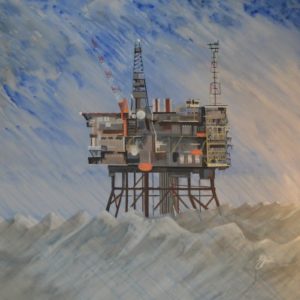
Forties Alpha Oil Platform in a Forties Gale
Forties Alpha Oil Rig in a Forties Gale, is a large 120cm x 120cm acrylic painting on canvas, with a complex mount and name plate.

Draugen Platform seen through the Eye of a Fish
Draugen Platform seen through the Eye of a Fish
The following text is from Wikipedia
‘Draugen Platform seen through the Eye of a Fish’ is an oil field in the Norwegian Sea with a sea depth of 250 metres (800 ft). It is operated by AS Norske Shell. The field has been developed with a concrete fixed facility and integrated topside. Stabilized oil is stored in tanks in the base of the facility. Two flowlines connect the facility to a floating loading buoy.
The Garn Vest and Rogn Sør deposits have been developed with a total of five subsea wells connected to the main facility at Draugen. The field has six subsea water injection wells. Additional resources in the Garn Vest structure came on stream in December 2001, while development of additional resources at the Rogn Sør structure were approved in the spring of 2001, coming on stream in January 2003.
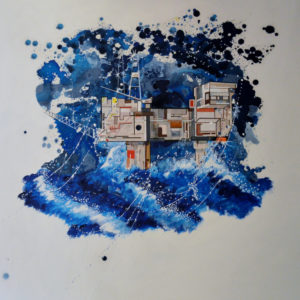
Cormorant Alpha with spuming seas
Cormorant Alpha with spuming seas This is a fantasy view of the Cormorant Alpha platform during high seas on a crisp Winters day. It measures 1 x 1m and is painted in acrylic on canvas. The waves lap, the wind howls and throws up spume from the waves. Cormorant Alpha with spuming seas is a large and imposing painting, ideal for a large room in a house or in an office space. This depiction was painted … Read More

Oil Platform in a Squall – A Fantasy of Engineering
Oil Platform in a Squall is a fantasy view of a fictitious platform during high seas. It measures 120 x 120cm and is painted in acrylic on canvas.
A large and imposing painting, ideal for a large room in a house or in some office space.

Transformer
Transformer
Transformer is a 30cm x 40cm acrylic on canvas. It is inspired by the film Caberet. Cabaret is a 1972 American musical drama film directed by Bob Fosse and starring Liza Minnelli, Michael York and Joel Grey. The film is set in Berlin during the Weimar Republic in 1931, under the presence of the growing Nazi Party.
In this painting an androgenous performer is depicted performing on stage.
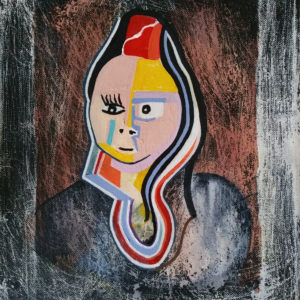
Woman in an Overcoat
Woman in an Overcoat
This is a H 35cm x W 28cm x D 2cm acrylic painting of a woman preparing to go outside in the cold. The distressed background and fake frame are tired and old whereas our subject is full of colour and ‘life’.
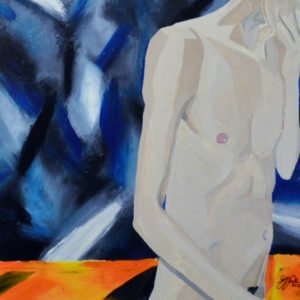
Pondering
Pondering is an acrylic painting presented on a 60cm x 80cm canvas. The bold blues contrast heavily with the oranges in the background and our figure stands wondering at something in his hand.

Fraternity!
Fraternity ! A Human Study Draped in the Tricolore
Fraternity is a 100cm x 60cm acrylic on canvas. The model is shown, just out of the shower and standing in an opening guarded by the French Tricolore flag.
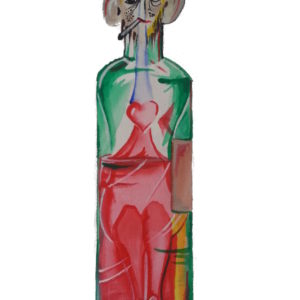
Bottled Matthew
Bottled Matthew
Bottled Matthew (30cm x 40cm) is a medium sized acrylic painting that shows the artist and his faults; drinking wine and chain smoking.
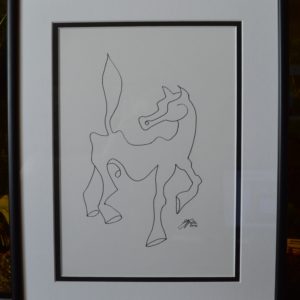
Prancing Pony
Prancing Pony
Prancing Pony is an A4 (21 x 30cm) , framed (25 x 35cm), ink line drawing of an Arab dressage pony. The simple line gives a sense of elegance and movement whilst keeping the drawing clean and tidy. I was inspired, like so many, by the grace of Arabian stallions when they compete in dressage events and I also have a colleague who competes in the events so it reminds me of him and his wife.
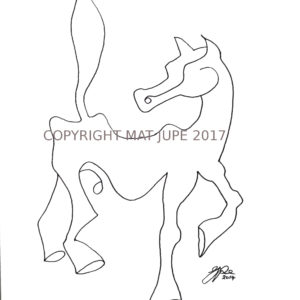
Prancing Pony – Limited Edition Print
Prancing Pony – Limited Edition Print
Prancing Pony – Limited Edition Print. A limited edition of 10 A4 (21 x 30cm)unmounted giclee prints are available.
Prancing Pony is an A4, copy of an ink line drawing of an Arab dressage pony. The simple line gives a sense of elegance and movement whilst keeping the drawing clean and tidy. I was inspired, like so many, by the grace of Arabian stallions when they compete in dressage events and I also have a colleague who competes in the events so it reminds me of him and his wife.

Birthday Boy – Bacon Roll
Birthday Boy – Bacon Roll
‘Birthday Boy – Bacon Roll’ is a small 20cm (w) x 28cm (H), self portrait translated from a photograph of my own son on his birthday. His birthday made me aware for the first time of the precious and all consuming love that one feels for ones children. The portrait I show here is ‘Bacon-ised’. (an homage to Francis Bacon’s distorted figures). I painted it as a bleak contrast to the photos of the birth of my own son. (see also the paintings of my son as ‘Dorian Grey.’)
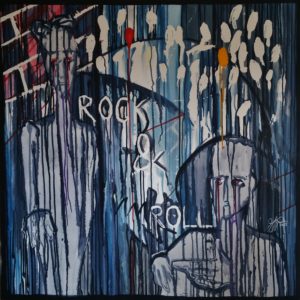
Rock & Roll
Rock & Roll
Rock & Roll is a large (1m x 1m) acrylic painting on stretched canvas. There are suggestions of rock and roll throughout the piece. There is also a large head in the centre of the painting belonging to a World War I trench soldier and this space doubles for a World War I War Horse
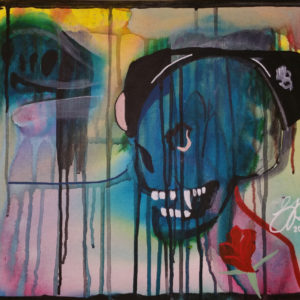
The Rose Bud Vampire
‘The Rose Bud Vampire’ ‘The Rose Bud Vampire’ is an acrylic painting drawn on a 18in x 14in stretched canvas. The work comprises primary yellow, primary cyan and primary magenta, with all the other colours being generated by the mixing of these three with water. The vampire, wearing Skull Candy, Hesh 2, head phones, is turning and calling to a vampire skeleton dog. The piece was painted on the 5th March 2016 in my hospital room … Read More
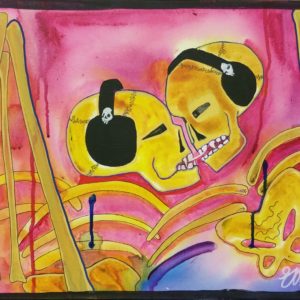
Bluetooth Bubble Gum Kiss
Bluetooth Bubble Gum Kiss
Bluetooth Bubble Gum Kiss, is an acrylic painting, comprised of primary yellow, primary magenta and primary cyan on a 18in x 14in stretched canvas.
The Vampire skeletons are enjoying a moment of joint isolation as they listen to their music oblivious to the world around them. Their moment is enhanced with them sharing a stick of bubble gum. Does it lead to a kiss, like the famous scene in the ‘Lady and the Tramp’? Yes, we think so.
The painting was finished on 6th March 2016 on Drum Ward, Royal Cornhill Hospital.
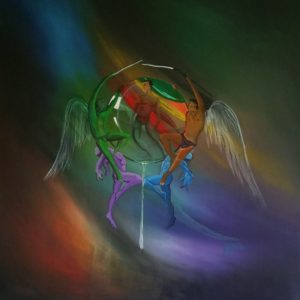
Titans, Gods & Men
Titans, Gods & Men is a large, 1m x 1m, colourful acrylic on canvas that suggests the relationship between the ancient mythical hierarchy of Titans, Gods & Men.
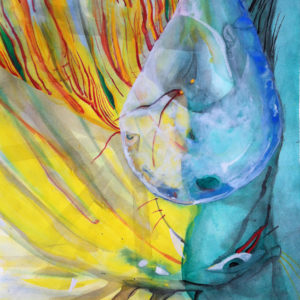
The Crucifixion No.2
The Crucifixion No.2
This work is important as it allows the viewer to rotate the painting 180°, a direction usually placing Christ upside down in a Satanic pose. However, with this painting as you rotate it 180° you reveal the Lion of Judea in all His Majesty… a horrific sight to those who would tempt to reverse the imagery of this religious icon. There is no way to hang this painting upside down.
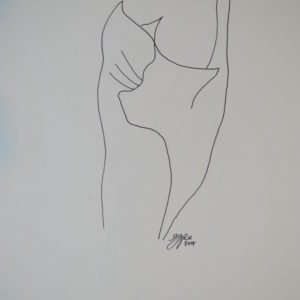
How Many Cats?
How Many Cats?
This ink drawing is a simple A4 line, from 2014, that begs the question ‘How many cats do you see on the page?’. I can see at least three but who am I to tell. *big smile*
